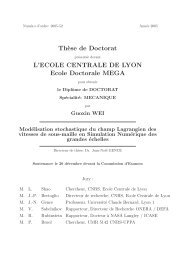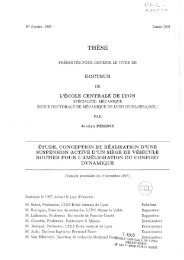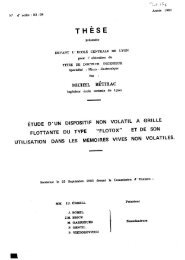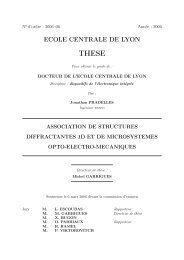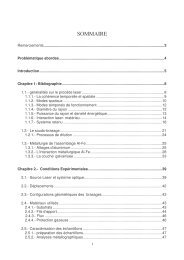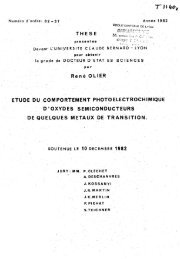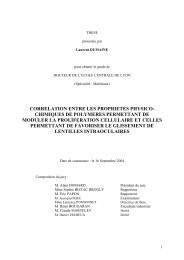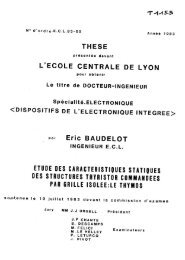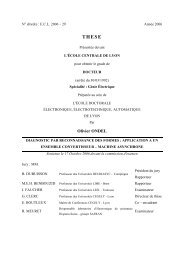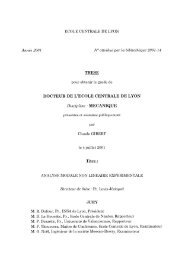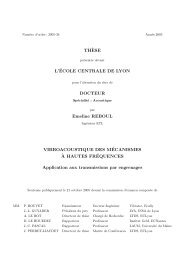these approches numeriques pour la simulation du bruit a large ...
these approches numeriques pour la simulation du bruit a large ...
these approches numeriques pour la simulation du bruit a large ...
You also want an ePaper? Increase the reach of your titles
YUMPU automatically turns print PDFs into web optimized ePapers that Google loves.
Abstract<br />
This study investigates the capability of unsteady CFD approaches to predict<br />
broadband noise sources. A special configuration is set-up, in which a rod (d=chord/10)<br />
sheds a subcritical vortex street (Red ∼ 48 000) that impinges onto a NACA0012<br />
airfoil. This is a relevant test-case for noise generation in turbomachines, combining<br />
tonal and broadband sources around an airfoil.<br />
The numerical approach undertaken relies on two steps:<br />
• First, unsteady aerodynamic computations are carried out and compared to results<br />
from an accompanying experiment. Comparisons include velocity and pressure spec-<br />
tra, as well as instantaneous flow field snapshots processed using recent techniques<br />
(Normalized Angu<strong>la</strong>r Momentum, Proper Orthogonal Decomposition).<br />
• Second, the acoustic far field is computed in the time domain using a version of<br />
the Ffowcs Williams & Hawkings analogy for arbitrary control surfaces, with an<br />
advanced time formu<strong>la</strong>tion. Results are compared to far field measurements both in<br />
terms of spectra and Sound Pressure Levels.<br />
Numerical simu<strong>la</strong>tion of broadband sources is very challenging because it involves<br />
a wide range of turbulent scales, and sound levels are far below aerodynamic ones.<br />
Two alternative ways of representing the broadband content are investigated (both<br />
implemented according to the two-step approach described above):<br />
• First, Unsteady Reynolds Averaged Navier Stokes (U-RANS) computations are<br />
tested with various k−ω turbulence closures. They all predict satisfactorily the mean<br />
flow quantities as well as the deterministic fluctuations, but the shedding frequency<br />
is overestimated (+25%). By construction, U-RANS does not simu<strong>la</strong>te the turbulent<br />
fluctuations, so a stochastic model of the spanwise fluctuations is implemented in<br />
the acoustic analogy to take into account the broadband dynamics. However, such<br />
a model might not be straightforward to develop for a turbomachine.<br />
• Conversely, Large-Eddy Simu<strong>la</strong>tion (LES) directly represents the main turbulent<br />
fluctuations. An auto-adaptive subgrid scale model is designed to be possibly applied<br />
to complex geometries, and is validated on c<strong>la</strong>ssical benchmarks. On the rod-airfoil,<br />
LES accurately simu<strong>la</strong>tes the mean quantities, and the turbulent flow dynamics. The<br />
snapshot comparisons show that the LES simu<strong>la</strong>tes the various scales inside the rod<br />
wake, and their interaction with the airfoil, in agreement with the PIV (U-RANS<br />
only predicts the two major POD modes). The broadband spectrum of the far field<br />
is very close to the experimental one for a wide range of frequencies.<br />
LES, despite its high computational cost, is a promising tool for the study of<br />
iso<strong>la</strong>ted turbomachinery broadband sources. It can also help to design affordable<br />
broadband models to apply to U-RANS data.



